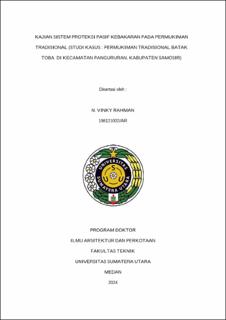| dc.description.abstract | Passive Protection Systems are fire protection systems built without mechanics and are
applied in the form of fire safety planning/engineering. This system has the best reliability
compared to other Fire Protection Systems because it is highly efficient and durable and
requires minimum inspection and maintenance. This dissertation aims to find a Passive
Fire Protection System (PFPS) in traditional settlements. Fires often occur in traditional
settlements that cause invaluable losses because the objects are the nation's cultural
heritage. The research object, namely the Toba Batak Traditional Settlement, Hutaraja-
Pardamean Village in Pangururan District, is a settlement that has become a Lake Toba
Super Priority Tourism Destination. Protective efforts are urgently needed to support
efforts to protect cultural heritage as tourism assets. This dissertation attempts to
summarize the PFPS variables on the object of study, namely traditional settlements, with
a case study of Toba Batak Traditional Settlements. The method used in this research
begins with a literature review to obtain aspects of PFPS suitable to the research object,
later called variables, indicators, and research parameters. The analysis method used the
AHP process to get hierarchical / importance values for each variable, indicator, and
PFPS parameter. The next step is an analysis process to determine the level of reliability
of PFPS parameters, indicators, and variables on the research object. This reliability level
value evaluates the accumulated Reliability Level in Toba Batak Traditional
settlements.Optimization of PFPS is obtained by conducting a correlation between the
calculation of hierarchical values and the level of reliability of the PFPS variables,
indicators, and parameters of the research object. Based on the literature search results,
Passive Protection System variables compatible with Traditional Settlements are Site
Design, Accessibility, Building Structure, Building Materials, and Building Spatial
Planning. It was also concluded that the structure variable, with a hierarchy of importance
value of 3.97%, has no significant effect on the passive fire protection of the research
object. The evaluation results on the Hutaraja-Pardamean Settlement research object
found that the PFPS reliability percentage value was 56.93% or classified as medium risk
classification, whose reliability still needs and can be further improved. The results of the
PFPS optimization calculations found that the Spatial Planning aspect and the Building
Materials aspect were the PFPS aspects that were priorities that needed to be carried out
to increase the reliability of the fire protection of the research object. Furthermore, based
on this optimization priority order, Site Design and Accessibility are the following
priorities for improvement. | en_US |


